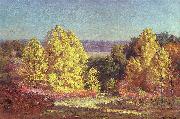Wholesale Oil Painting Reproductions No Minimum and Door to Door! |
|||||||||||
|
|
|||||||||||

|
|||||||||||
|
|
|
||||||||
All Theodore Clement Steele Oil Paintings |
||||||||
|
|
||||||||
|
|
||||||||
|
Artist Introduction: 1847-1926
Theodore Clement Steele Galleries
Theodore Clement Steele (September 11, 1847-July 24, 1926) was an American Impressionist painter known for his Indiana landscapes. Steele was born in Owen County, Indiana, and later moved to Indianapolis after study in Cincinnati, Chicago and Munich. He is considered to be the most important of the Hoosier Group of painters and his work is widely collected by museums and individuals. Steele earned his living primarily as a portrait painter and his portraits include one of notable Hoosier Poet James Whitcomb Riley and the official portraits of several Indiana governors. Steele exhibited at and was on the art selection for the Louisiana Purchase Exposition in 1904 and was elected to the National Academy of Design in 1913. He enjoyed plein air, or outdoor, painting, which is reflected in many of the landscapes he painted. Steele went through a notable change in style after his return from Munich in 1885. Steele's work, which in the Munich time period sported drab colors and high contrasts, shifted towards a brighter, more vivid color palette after his return to Indiana. Upon T.C. Steele's return, his family lived in the Talbot House, or Tinker Mansion, which is at what is now 16th and Pennsylvania Streets in Indianapolis. In 1898, Steele and J. Ottis Adams bought a home in Brookville, Indiana, which they called "The Hermitage." Steele sold his interest in the home to Adams after the death of his first wife.
He received an honorary master's degree from Wabash College in 1900 and an honorary doctorate from Indiana University in 1916. |
||||||||
|
|
||||||||
|
The Poplars Painting ID:: 4507 |
1914 |
|||||||
Height Width |
INS/CM Quality |
|||||||
|
X |
| |||||||
|
|
||||||||
|
Prev Next
|
||||||||
|
|
||||||||
|
Related Paintings to Paul Cezanne :. |
||||||||
|
|
||||||||
|
CONTACT US |

